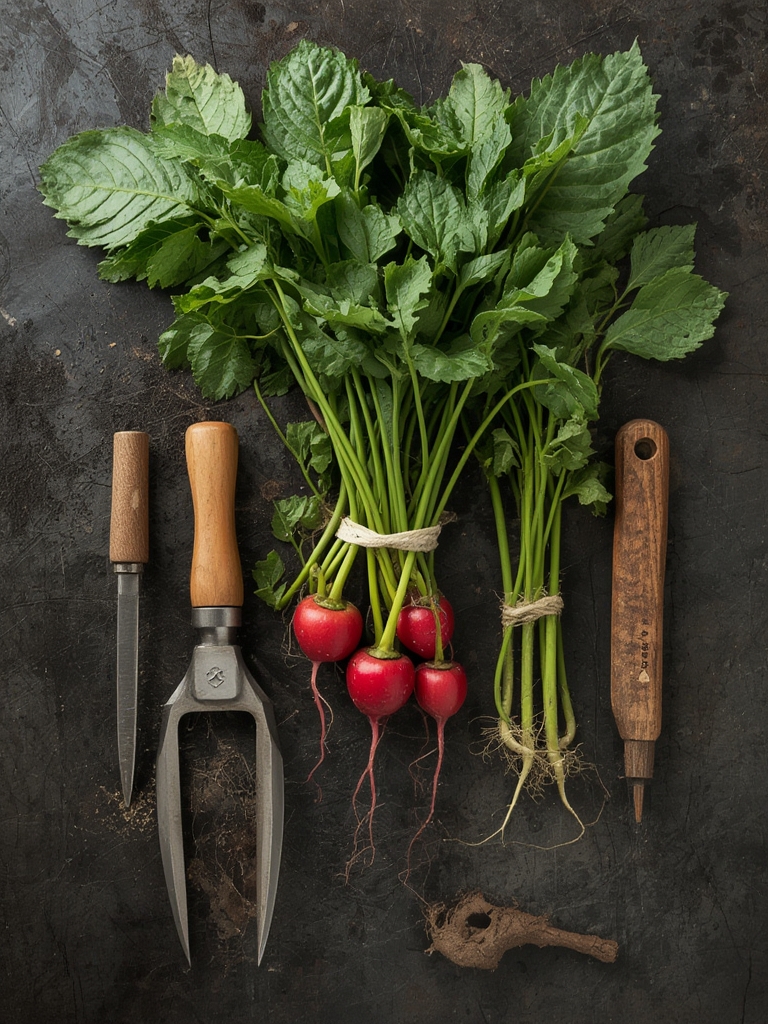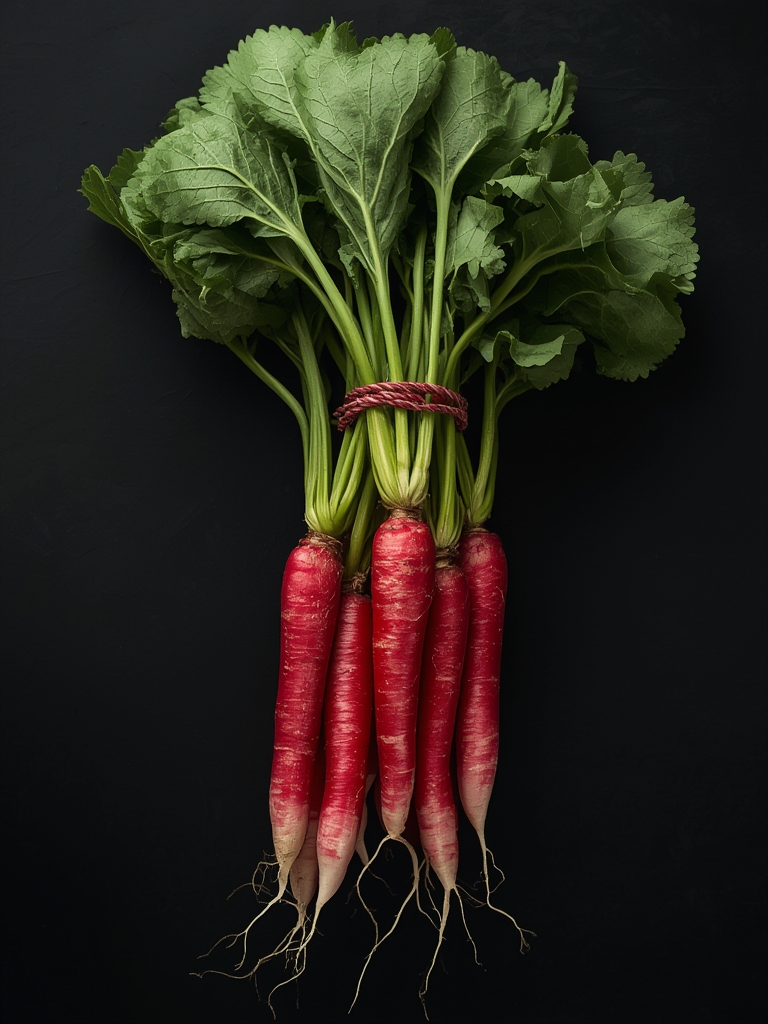Growing Radishes at home is one of the most rewarding experiences for both novice and experienced gardeners. Have you ever wondered why these crisp, peppery vegetables are considered the perfect starter crop? With their lightning-fast growth cycle and minimal care requirements, radishes offer almost instant gratification in your garden. Whether you’re working with limited space or want to introduce children to gardening, these root vegetables deliver results in just 3-4 weeks. Let’s explore how you can successfully grow red radishes and other varieties in your own garden or containers.
Materials & Supplies

To get started with growing radishes, you’ll need:
- Radish seeds (Cherry Belle, French Breakfast, or White Icicle varieties)
- Well-draining potting soil or garden soil amended with compost
- Garden space or containers at least 6 inches deep
- Watering can or irrigation system
- Basic garden tools (trowel, rake, garden gloves)
- Plant markers or labels
- Fine-mesh netting (optional, for pest protection)
- Organic fertilizer (optional, but beneficial for container growing)
- pH testing kit (optional, radishes prefer slightly acidic soil)
Timing / Growing Schedule
Radishes are cool-season crops that perform best in spring and fall. From seed to harvest, most varieties take just 21-30 days, making them among the fastest-growing vegetables available. For continuous harvests, plant small batches every 7-10 days. Spring plantings should begin 4-6 weeks before the last frost date, while fall plantings can start 4-6 weeks before the first expected frost. Summer heat causes radishes to bolt and become woody, so avoid planting during the hottest months unless you can provide afternoon shade.
Step-by-Step Instructions

-
Prepare your soil: Loosen the soil to a depth of 6-8 inches. Remove rocks and break up any clumps for smooth, consistent growing medium. For containers, ensure proper drainage holes.
-
Sow seeds directly: Plant seeds ½ inch deep and 1 inch apart in rows spaced 4 inches apart. For container growing, scatter seeds and cover lightly with soil.
-
Water gently: Use a fine spray to avoid displacing seeds. Keep soil consistently moist but not waterlogged. Pro tip: Apply water at the soil level rather than from overhead to prevent disease.
-
Thin seedlings: When plants reach 1 inch tall, thin to 2 inches apart for standard varieties. Save the thinnings for salads—they’re perfectly edible!
-
Maintain moisture: Provide 1 inch of water weekly. Inconsistent watering leads to split or pithy radishes.
-
Harvest promptly: Pull radishes when they reach marble size (typically 3-4 weeks after planting). Delayed harvesting results in woody, pungent vegetables.
Nutritional Benefits
Radishes are nutritional powerhouses packed into small packages. They’re rich in vitamin C, potassium, and folate while being extremely low in calories. The compounds that give radishes their distinctive spicy flavor also support digestive health and contain antioxidants. Growing them yourself ensures maximum freshness and nutrient retention compared to store-bought options.
Tips and Alternative Methods
- Container growing: Choose containers at least 6 inches deep with drainage holes. Radishes thrive in window boxes and fabric grow bags.
- Companion planting: Grow alongside lettuce, spinach, or peas, which don’t compete for root space.
- Succession planting: Sow small batches every 7-10 days for continuous harvests.
- Winter growing: Some varieties like Daikon can be planted in late summer for fall/winter harvests.
- Indoor cultivation: Grow on sunny windowsills or under grow lights year-round.
Common Mistakes to Avoid
- Overcrowding: Failing to thin seedlings results in small, deformed roots.
- Inconsistent watering: Causes splitting, woodiness, and excessive pungency.
- Over-fertilizing: Too much nitrogen promotes lush leaves at the expense of root development.
- Planting in summer heat: High temperatures cause bolting and bitter flavors.
- Delayed harvesting: Waiting too long leads to tough, pithy texture.
Storage / Maintenance Tips
Remove greens before storing radishes to prevent moisture loss. Unwashed radishes stay crisp in the refrigerator for 1-2 weeks when stored in perforated plastic bags. For maintenance, keep beds weed-free, as radishes don’t compete well with weeds. Apply light mulch to maintain soil moisture and temperature. Watch for flea beetles, which can be deterred with row covers.
Conclusion
Growing Radishes offers a perfect entry point to vegetable gardening with their quick results and minimal fuss. Their peppery crunch and nutritional benefits make them well worth the minimal effort required. Whether in garden beds or containers, these vibrant vegetables provide satisfaction in just weeks. Try growing different varieties to discover your favorites, and don’t forget to experiment with the edible greens as well as the roots!
FAQs
- Why are my radishes growing lots of leaves but small roots?
This usually indicates too much nitrogen in the soil or insufficient sunlight. Reduce fertilizer and ensure at least 6 hours of direct sunlight daily. - Can I grow radishes indoors?
Yes! Use containers at least 6 inches deep near a sunny window or under grow lights. Ensure good drainage and consistent moisture. - How do I prevent my radishes from becoming too spicy?
Consistent watering and harvesting at the right time (when young) helps reduce excessive pungency. Growing in cooler weather also produces milder radishes. - Can I eat radish greens?
Absolutely! Young radish greens are delicious in salads or sautéed like spinach. They’re rich in vitamin C, calcium, and protein. - Why do my radishes split open?
Splitting typically occurs from inconsistent watering or leaving them in the ground too long after they mature. Water regularly and harvest promptly.







